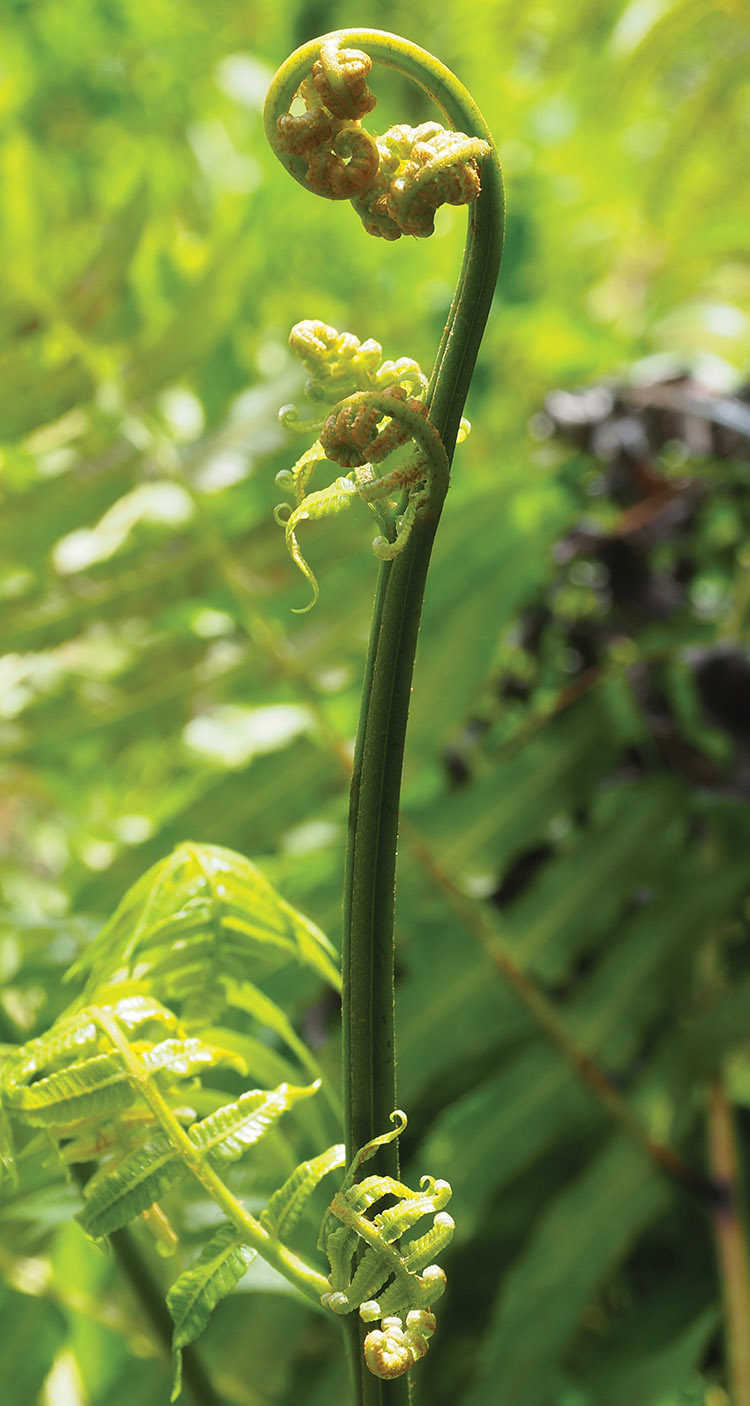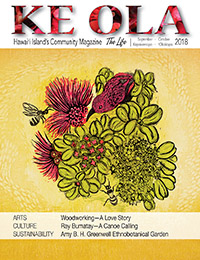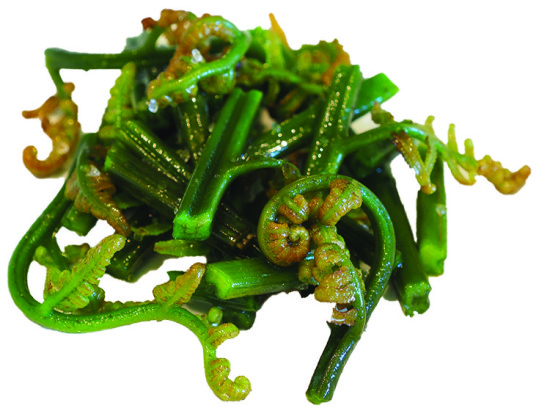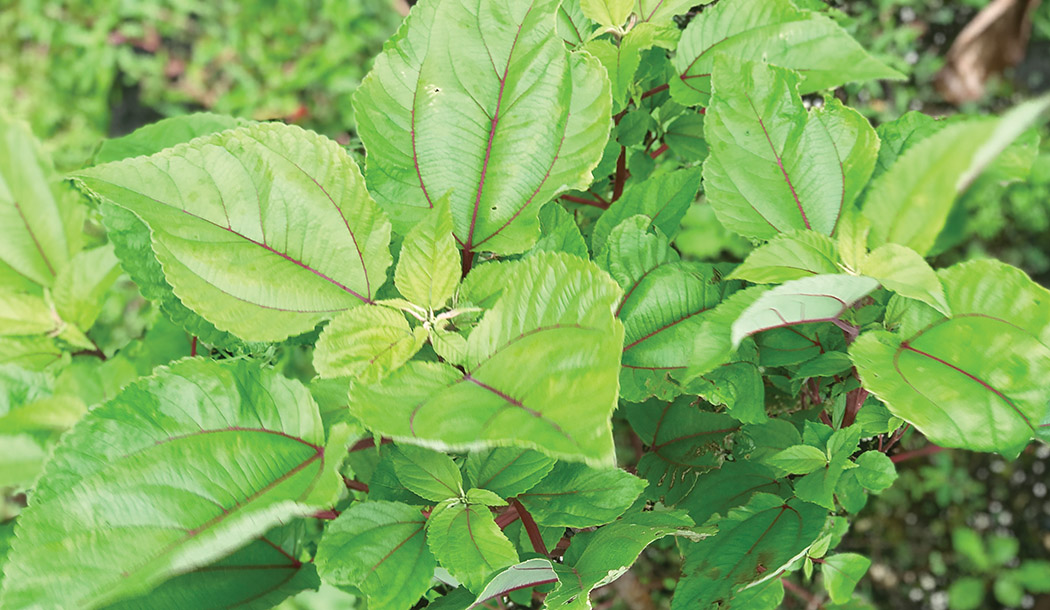
Local Foods: Hawai‘i Island Hō‘i‘o (Fiddlehead Fern)
 By Brittany P. Anderson
By Brittany P. Anderson
It’s one of those rainy days, when the sky is filled with endless layers of clouds painted with broad strokes of lilac and gray. Looking out at the ocean, I see dark indigo patches of rain squalls marching towards land. I trudge through the pasture with my trusty bucket to the back corner of my farm. The grassy edge of the field turns into a canopy of bamboo near our stream. Here, my hands search for tender green bracken fern tendrils poking out from under lacy green leaves. Harvesting the fresh wild hō‘i‘o is meditative, a state of feeling like I am the only one on this big, big island.
Commonly known as fiddlehead fern, on O‘ahu and Hawai‘i Island it is known as hō‘i‘o, in the Philippines it is pako, warabi in Japan, and on Maui it is called pohole. We are lucky the tender shoots of this bracken fern variety are available year-round on Hawai‘i Island.
For centuries, the curled fern shoots have been eaten as a vegetable in traditional diets across Europe, Asia, and by Native Hawaiians. It is also one of the oldest ferns, with fossil records over 55 million years old.
Bracken ferns need clean fresh water, a wet climate, and do well in dappled shade as well as full sun. My ferns grow higher than four feet tall, enjoying the tropical rainforest setting and cool, clear water running down from Maunakea.
Hō‘i‘o are young leaf shoots, plucked carefully within 14 days of the first signs of unfurling. Running your fingers down the stem, snap just above where the flesh becomes woody: it should break easily with mild pressure. The best hō‘i‘o are shiny with dark emerald green stems and tightly curled heads. There is a light auburn fuzz on the coiled head and stem that will need to be gently washed off before cooking.
Most hō‘i‘o at farmers’ markets and restaurants are foraged, though there are a few commercial operations. When collecting hō‘i‘o, take only half the fiddleheads you find, to ensure a sustainable harvest. Every fern plant makes several shoots that turn into fronds. Repeated over-picking can kill the plant.
The flavor of hō‘i‘o can be described as a mix between okra, fr

esh asparagus, and button mushroom. In the Hawaiian legend of Nā Piliwale, the fern’s flavor is so alluring, it was used as a trap to stop the dreadful Piliwale sisters. As the legend goes, the Piliwale sisters were terrible creatures with sharp teeth, stick arms and legs, and huge swollen bellies due to their insatiable appetite. The Piliwale wreaked havoc by night and slept in caves by day because if a ray of sun touched their skin, they would turn to stone.
They traveled the islands expecting each village to feed them and if the villagers did not give the sisters enough, the Piliwale caused landslides and floods. The only thing that could satisfy their appetite was hō‘i‘o. While in Hā‘ena, Kaua‘i chief Lohi‘au drew out a long feast and just before daybreak brought out a dish of hō‘i‘o and ‘ōpae (shrimp) sprinkled with salt. Eating their favorite meal, Lohi‘au exposed the Piliwale to sunlight, and their reign of terror ended as they turned to stone.
With my bucket full of hō‘i‘o, I slosh my way back through the pasture. A break in the clouds allows a few rays of sunshine to warm my face and I can’t help but think of the Piliwale turning to stone as they demand to gobble up this hō‘i‘o harvest.
Hō‘i‘o Recipe
1 bunch of hō‘i‘o, washed (see note below)
1 Tbs coconut oil
Sea salt to taste
½ cup limu (seaweed), optional
Method
 Cut hō‘i‘o into roughly 1-inch pieces. Blanch ferns for 10–30 seconds by drenching in pot of water that has reached a rolling boil. Remove shoots immediately with a slotted spoon and place on serving plate. Drizzle with coconut oil and sprinkle with sea salt. You can add limu on top as well. Serve immediately.
Cut hō‘i‘o into roughly 1-inch pieces. Blanch ferns for 10–30 seconds by drenching in pot of water that has reached a rolling boil. Remove shoots immediately with a slotted spoon and place on serving plate. Drizzle with coconut oil and sprinkle with sea salt. You can add limu on top as well. Serve immediately.
Note
Prepare hō‘i‘o by cutting two inches off the bottom of stalk. Wash thoroughly to remove hairs or any debris. Take care when washing the curled tips to not break or bruise the area. Hō‘i‘o degrade quickly and should be used immediately.


